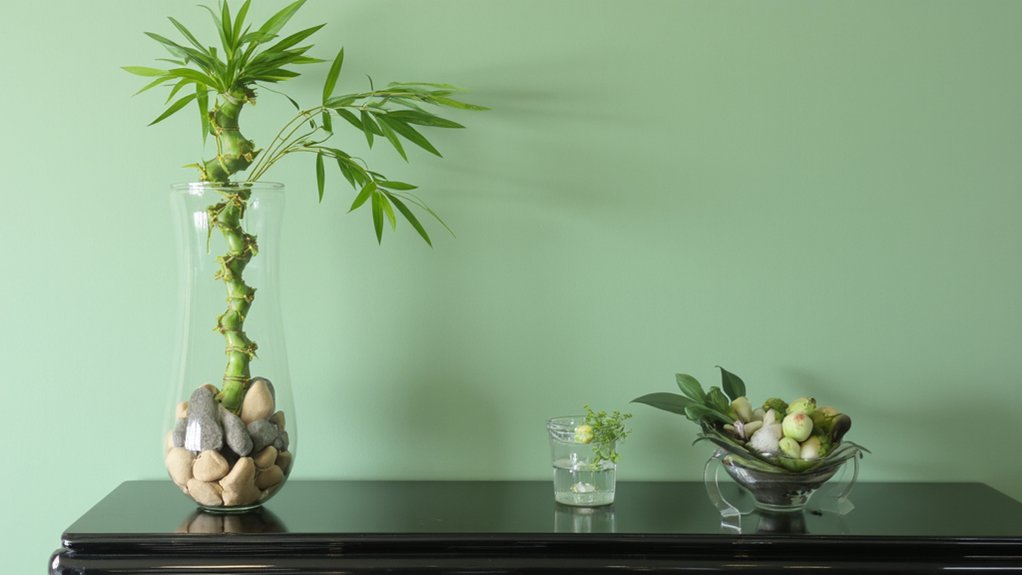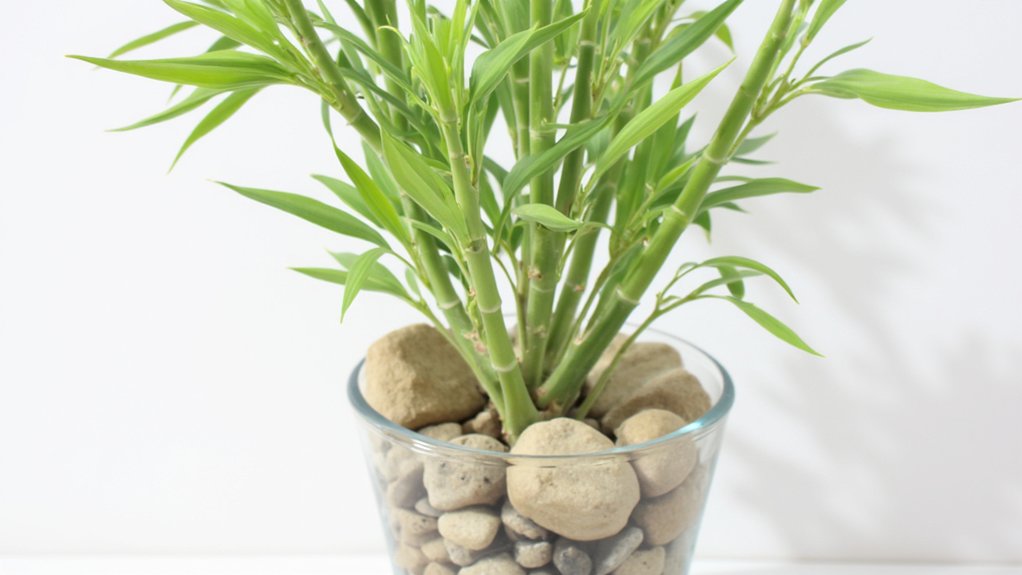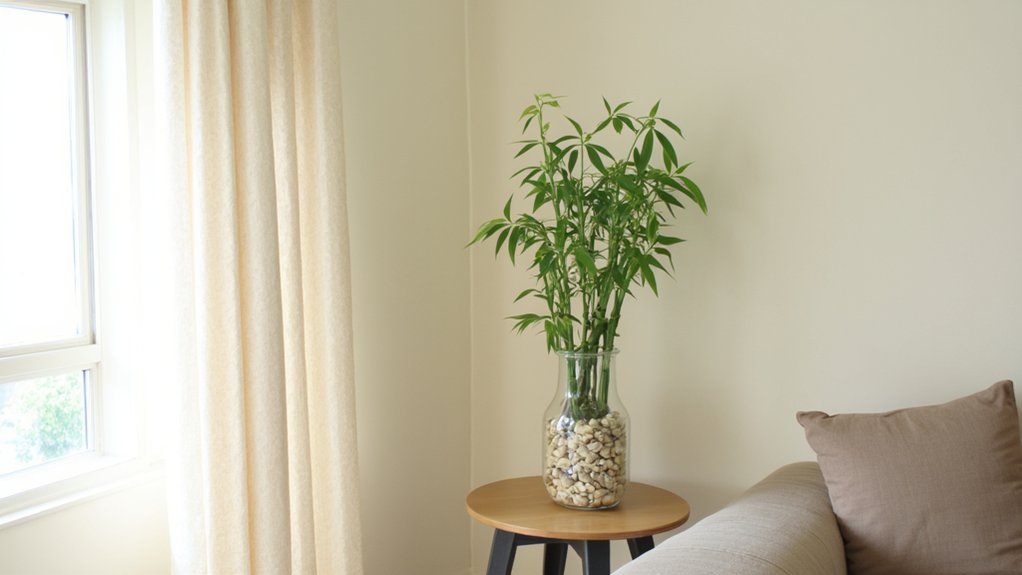You’ve probably seen those elegant spiral stalks of “lucky bamboo” adorning homes and offices, promising to attract wealth and good fortune. While these popular plants aren’t actually bamboo at all, they’ve managed to cultivate quite a reputation across cultures for their supposed prosperity-boosting powers. Before you dismiss these claims as mere superstition or rush out to buy a dozen stems, let’s examine what science and tradition really say about these mysterious green charmers.
Contents
- 1 The Origins and History of Lucky Bamboo
- 2 Debunking the Bamboo Myth: Meet Dracaena Sanderiana
- 3 Feng Shui Principles and Lucky Bamboo Placement
- 4 Scientific Benefits of Growing Lucky Bamboo Indoors
- 5 Cultural Symbolism and Lucky Bamboo Arrangements
- 6 Essential Care Tips for Thriving Lucky Bamboo
- 7 Lucky Bamboo in Modern Home and Office Design
- 8 The Psychology Behind Lucky Plants and Well-being
- 9 Common Problems and Solutions for Lucky Bamboo
- 10 Research and Studies on Plants and Prosperity
The Origins and History of Lucky Bamboo

Lucky bamboo’s history stretches back over 4,000 years to the ancient forests of Cameroon and West Africa. You’ll find that this plant, which isn’t actually bamboo but a species of Dracaena, made its way to China during the Han Dynasty through maritime trade routes.
In Chinese culture, you’ll discover that it’s known as “Fu Gwey Zhu,” meaning wealth and fortune bamboo. The plant’s popularity exploded during the 1980s, when Asian markets began exporting it worldwide as a feng shui element.
Today, you’ll see lucky bamboo adorning homes and offices across the globe, with its distinctive spiral stalks and intricate arrangements that symbolize different aspects of prosperity.
Debunking the Bamboo Myth: Meet Dracaena Sanderiana

Despite its common name and appearance, the plant you’ve known as lucky bamboo isn’t bamboo at all. It’s actually Dracaena sanderiana, a member of the Asparagaceae family that’s native to Central Africa’s tropical rainforests.
You can spot the difference by examining the plant’s structure. True bamboo develops complex root systems and grows segments called internodes, while your Dracaena grows from a single stem with lateral shoots. The leaves are different too – Dracaena’s are broader and more sword-like than bamboo’s characteristic grass-like foliage.
When you’re shopping, you’ll often find it labeled as Chinese water bamboo or ribbon plant, but these are just marketing names.
Feng Shui Principles and Lucky Bamboo Placement

When arranging your Dracaena sanderiana according to feng shui principles, you’ll want to focus on the bagua map’s energy zones within your space. The southeast area, associated with wealth and abundance, is considered the most auspicious placement for your lucky bamboo.
You’ll achieve ideal energy flow by positioning your plant 2-3 feet from walls or corners, keeping it at eye level or below. Place an odd number of stalks – three for happiness, five for health, or seven for prosperity – in a clear glass container filled with filtered water.
Remember to rotate your lucky bamboo 45 degrees every two weeks to guarantee balanced growth and energy distribution.
Scientific Benefits of Growing Lucky Bamboo Indoors
Beyond its cultural significance, indoor lucky bamboo provides scientifically proven benefits for your living space. The plant naturally filters indoor air pollutants, particularly benzene and formaldehyde, through its leaves and root system.
You’ll appreciate how lucky bamboo increases humidity levels by up to 5% in dry rooms through transpiration. Its oxygen production peaks during daylight hours, making it ideal for home offices and workspaces.
Studies show that having lucky bamboo in your line of sight can reduce eye strain by 15% when you’re working at a computer, as its vertical green stems provide a natural focal point for periodic vision breaks.
Cultural Symbolism and Lucky Bamboo Arrangements
The cultural significance of lucky bamboo extends far deeper than its proven health benefits. In Chinese tradition, you’ll find specific meanings tied to the number of stalks in each arrangement: two stalks represent love, three bring happiness, five offer wealth, and six attract good fortune.
You can enhance your lucky bamboo’s symbolic power by positioning it in the proper Feng Shui location. Place arrangements with wealth-attracting stalks in your home’s southeast corner, or set love-focused designs in your bedroom’s southwest area.
Consider binding red ribbon around the stalks and adding authentic Chinese coins to amplify the plant’s traditional benefits.
Essential Care Tips for Thriving Lucky Bamboo
Although lucky bamboo maintains a reputation for being low-maintenance, proper care greatly impacts its health and longevity. You’ll need to keep your plant in filtered water that’s changed every 7-10 days, making sure the roots stay submerged while the stalks remain above water.
Place your lucky bamboo in indirect sunlight and maintain room temperatures between 65-85°F. When roots become crowded, it’s time to repot. You can use clean pebbles for support, but avoid tap water, which contains chemicals that may turn leaves yellow.
Add one drop of liquid fertilizer monthly during growing season, and trim yellowing leaves promptly to prevent disease spread.
Lucky Bamboo in Modern Home and Office Design
Modern interior designers frequently incorporate lucky bamboo as a striking focal point, bringing both aesthetic appeal and feng shui benefits to contemporary spaces. You’ll find these versatile plants adorning minimalist desks, sleek reception areas, and modern living rooms.
For maximum impact, place your lucky bamboo in clear glass containers filled with polished stones. Standard heights range from 4 to 24 inches, though taller specimens can reach 36 inches. Consider grouping different heights in odd numbers.
In office settings, position the bamboo in the wealth corner (southeast) of your workspace. For home design, create zen-inspired arrangements using white ceramic vessels and natural river rocks.
The Psychology Behind Lucky Plants and Well-being
Scientific research confirms that keeping lucky plants like bamboo doesn’t just lift your spirits through superstition – they actually trigger measurable psychological benefits. Studies show that having plants in your space can reduce stress levels by up to 37% and increase productivity by 15%.
When you interact with lucky bamboo, you’re engaging in a form of mindfulness practice. The act of caring for plants releases dopamine and serotonin, while the visual presence of greenery can lower blood pressure and heart rate. You’ll find that tending to your bamboo creates a sense of purpose and routine, contributing to improved mental well-being.
Common Problems and Solutions for Lucky Bamboo
While lucky bamboo is generally hardy and adaptable, you’ll likely encounter several common growing issues that can affect its health and appearance. Yellow leaves often signal overwatering or too much direct sunlight, while brown tips typically indicate tap water’s fluoride content or low humidity.
If you notice algae growth in the water, change it weekly and clean the container thoroughly. For rotting stems, trim affected areas with sterilized scissors and maintain water at 1-2 inches deep. Black stems require immediate removal to prevent spread.
To prevent most issues, keep your plant in filtered light, use distilled water, and maintain temperatures between 65-80°F (18-27°C).
Research and Studies on Plants and Prosperity
Beyond the practical care guidelines for lucky bamboo, researchers have explored fascinating connections between indoor plants and financial well-being. A 2019 study at the University of Tokyo found that offices with plants saw a 15% increase in productivity and revenue compared to plant-free spaces.
You’ll find scientific evidence suggesting that plants like lucky bamboo can reduce stress levels by up to 37%, leading to better decision-making in financial matters. Research from Texas A&M showed that employees working near plants reported feeling more confident about money management and demonstrated improved problem-solving skills in business scenarios.
